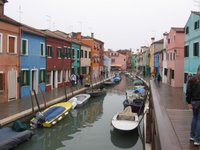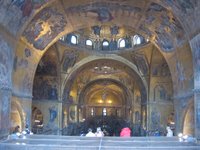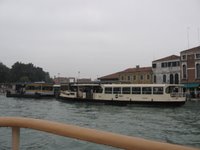I visited Venice for the second time this year, this time with my parents whose last visit was more than 30 years ago. Venice left us with a very lasting impression on several fronts.
First of all, Venice is totally free of cars! Everything is done or carried through the extensive network of waterways criss-crossing the city, including private transport, public transport, fire and ambulance services and even FedEx. There’s no need to worry about crossing the roads and watching oncoming traffic!
But navigating through Venice is no easy matter, as it is incredibly easy to get lost. Even maps won’t help all the time, because the maps can’t list all the little canals, bridges and the narrow passageways that seem to make unpredictable turns. On the other hand, Venice is the prefect place for hide-and-seek and labyrinths because of this!
Tourists are both loved and loathed by the locals. On one hand, there are just too many tourists roaming everywhere in Venice, especially the famous tourist spots. It’s hardly possible to find some peace and tranquillity anywhere. However, tourists do bring in lots of money and are good targets for milking, and the blatant exploitations wouldn’t stop as long as there are always more tourists coming. My parents and I still remembered our set dinner which cost 15 euros at a restaurant. We never anticipated that the ‘chicken’ on the main course was in fact a rather small drumstick! That was of course not very satisfying even though we had had some pasta before and desserts afterwards. Another day we wanted to try a local pastry which came with a price tag of 2.2 euros. We found out eventually, to our shock, the price was in fact 2.2 euros per 100 g, and we paid more than 4 euros for it! We could only blame ourselves for not being able to read the price tag. That had got to be the most expensive pastry we have had for our whole lives, and we vowed not to waste any crumb of it.
The worst and most outrageous money-raking scheme of Venice is undoubtedly the public toilets which cost 1 euro entry. Make sure you carry enough coins with you, or you’ll be in big trouble for nature’s call – looking for toilets is already not too easy in Venice.
The Venetians have made more than enough money from the tourists, but one can’t help to think where the money has gone. Many places seem to be in a neglected, run-down state, and the people do not look particularly wealthy. Is it because maintenance of tourist spots and facilities has sucked away all the money already?
A bigger problem for Venice, however, is the danger of submersion through floods and ground-sinking. This time, we witnessed how the San Marco square was flooded by the rising waters of the Grand Canal which lay right next to the square. It doesn’t take too much of a rise in water levels for a spill-over to occur. It is not hard to picture the scenes of the massive flooding a few years ago, when one could even row gondolas in the square. Will Venice survive submersion and last? Maybe it’s not so sure after all. When I told a friend of mine how we became captive to the tourist trap of Venice, I remarked that all those merchants of Venice must be making an all-out effort to milk as much out of tourists as possible before Venice became another Atlantis. Don’t be put off visiting Venice because of this, but just be prepared for the nasty surprises!
這次跟父母雖是舊地重遊,但我們對威尼斯也有新的體會。究竟威尼斯令我們最深刻的印象有甚麼?
威尼斯是個完全無車的城市,而由於水道多,所以甚麼都以船當車,不論代步、公共交通、消防、救護,以至速遞,都用船解決,不用擔心過馬路的問題。
在威尼斯走動的最大難題,倒是極易迷途,有時就算有地圖也不管用,一來小橋流水太多,二則橫街窄巷多兼迂回曲折,地圖也未必盡錄,所以玩迷宮或捉迷藏,威尼斯絕對是首選之地!
威尼斯人對遊客又愛又恨,恨在人太多,又集中在幾個景點,找個清靜地方也不易,但遊客的錢實在太容易賺了,而且客源不絕,所以商戶宰客都很放心,比方15歐元(150港元)套餐中的主菜,所謂「雞」其實祇是雞下腿一小件,就算吃過意粉前菜和甜點也覺肚餓。有次在麫包店買地道麫包,看見標價2.2歐元(22港元,在香港一定算貴,在歐洲還可接受),便買個嚐嚐,怎料原來是按重量計算,是每100克2.2歐元(祇好怪自己看不懂價錢牌),結果花了4塊多歐元(40多港元),這個一輩子最昂貴的麫包,真的連麫包屑也不能放過!
最會敲遊客主意的,莫過於收費公廁,每次收1歐元(10港元),所以務必隨身帶備足夠零錢,免得人有三急時徬徨——找公廁已不易了!
但既然從遊客歉了不少財,為甚麼威尼斯及鄰近地區仍是「古道西風瘦馬」?究竟錢往何處去?是不是修葺古蹟已耗費驚人?
威尼斯最大的危機,就是陸沈及容易水淹,這次給我在聖馬可廣場目睹了,廣場就在大運河畔,水位稍稍上升便會湧入廣場,大可想像數年前大水災時,在廣場可以搖櫓的情景,究竟威尼斯能捱多久?會不會永久淹沒?我跟一個朋友談到被宰的經歷時打趣道,那班威尼斯商人想必趁沒落前盡撈遊客一筆才善甘罷休。你甘不甘心做他們下一隻羔羊?我想,這個世上獨一無二的地方,倒也值得見識一下。
Date of Visit: 21 - 22 October, 2006 到訪日期:2006年10月21-22日


Some of the many waterways of Venice 威尼斯的水道


The streets of Venice 威尼斯街景


The Grand Canal of Venice - views from the Santa Lucia railway station (left) and the Rialto Bridge (right)
威尼斯的大運河——從Santa Lucia火車總站(左)及Rialto橋(右)攝


The island of Murano near Venice, famous for glass-blowing
威尼斯鄰近的Murano島,以燒玻璃為名



The fishing village of Burano island with its colourful houses, leaning tower of the church and fabrication of lace
Burano島的漁村,特色在於色彩繽紛的民居(左上、右上)、教堂斜塔(左下)及通花剌鏽


The two famous buildings at San Marco Square: Basilica San Marco (left) and Palazzo Ducale (right)
聖馬可廣場最著名的建築:聖馬可大教堂(左)及總督府(右)


Floods at the San Marco Square! 聖馬可廣場水淹!



The decorations of the Basilica 教堂的裝潢


The view of San Marco Square from the Loggia of the Basilica
從大教堂閣樓俯視聖馬可廣場





Venice is full of vessels! (From top left) Private vessel at the doorstep, ambulance, fire service (yes, this is a fire station!), transport for the masses, and transport for the privileged.
「舟」水馬龍的威尼斯:(從左上起)住宅後門的私用船、救護船、消防局、公共交通及富貴人家的享受
First of all, Venice is totally free of cars! Everything is done or carried through the extensive network of waterways criss-crossing the city, including private transport, public transport, fire and ambulance services and even FedEx. There’s no need to worry about crossing the roads and watching oncoming traffic!
But navigating through Venice is no easy matter, as it is incredibly easy to get lost. Even maps won’t help all the time, because the maps can’t list all the little canals, bridges and the narrow passageways that seem to make unpredictable turns. On the other hand, Venice is the prefect place for hide-and-seek and labyrinths because of this!
Tourists are both loved and loathed by the locals. On one hand, there are just too many tourists roaming everywhere in Venice, especially the famous tourist spots. It’s hardly possible to find some peace and tranquillity anywhere. However, tourists do bring in lots of money and are good targets for milking, and the blatant exploitations wouldn’t stop as long as there are always more tourists coming. My parents and I still remembered our set dinner which cost 15 euros at a restaurant. We never anticipated that the ‘chicken’ on the main course was in fact a rather small drumstick! That was of course not very satisfying even though we had had some pasta before and desserts afterwards. Another day we wanted to try a local pastry which came with a price tag of 2.2 euros. We found out eventually, to our shock, the price was in fact 2.2 euros per 100 g, and we paid more than 4 euros for it! We could only blame ourselves for not being able to read the price tag. That had got to be the most expensive pastry we have had for our whole lives, and we vowed not to waste any crumb of it.
The worst and most outrageous money-raking scheme of Venice is undoubtedly the public toilets which cost 1 euro entry. Make sure you carry enough coins with you, or you’ll be in big trouble for nature’s call – looking for toilets is already not too easy in Venice.
The Venetians have made more than enough money from the tourists, but one can’t help to think where the money has gone. Many places seem to be in a neglected, run-down state, and the people do not look particularly wealthy. Is it because maintenance of tourist spots and facilities has sucked away all the money already?
A bigger problem for Venice, however, is the danger of submersion through floods and ground-sinking. This time, we witnessed how the San Marco square was flooded by the rising waters of the Grand Canal which lay right next to the square. It doesn’t take too much of a rise in water levels for a spill-over to occur. It is not hard to picture the scenes of the massive flooding a few years ago, when one could even row gondolas in the square. Will Venice survive submersion and last? Maybe it’s not so sure after all. When I told a friend of mine how we became captive to the tourist trap of Venice, I remarked that all those merchants of Venice must be making an all-out effort to milk as much out of tourists as possible before Venice became another Atlantis. Don’t be put off visiting Venice because of this, but just be prepared for the nasty surprises!
這次跟父母雖是舊地重遊,但我們對威尼斯也有新的體會。究竟威尼斯令我們最深刻的印象有甚麼?
威尼斯是個完全無車的城市,而由於水道多,所以甚麼都以船當車,不論代步、公共交通、消防、救護,以至速遞,都用船解決,不用擔心過馬路的問題。
在威尼斯走動的最大難題,倒是極易迷途,有時就算有地圖也不管用,一來小橋流水太多,二則橫街窄巷多兼迂回曲折,地圖也未必盡錄,所以玩迷宮或捉迷藏,威尼斯絕對是首選之地!
威尼斯人對遊客又愛又恨,恨在人太多,又集中在幾個景點,找個清靜地方也不易,但遊客的錢實在太容易賺了,而且客源不絕,所以商戶宰客都很放心,比方15歐元(150港元)套餐中的主菜,所謂「雞」其實祇是雞下腿一小件,就算吃過意粉前菜和甜點也覺肚餓。有次在麫包店買地道麫包,看見標價2.2歐元(22港元,在香港一定算貴,在歐洲還可接受),便買個嚐嚐,怎料原來是按重量計算,是每100克2.2歐元(祇好怪自己看不懂價錢牌),結果花了4塊多歐元(40多港元),這個一輩子最昂貴的麫包,真的連麫包屑也不能放過!
最會敲遊客主意的,莫過於收費公廁,每次收1歐元(10港元),所以務必隨身帶備足夠零錢,免得人有三急時徬徨——找公廁已不易了!
但既然從遊客歉了不少財,為甚麼威尼斯及鄰近地區仍是「古道西風瘦馬」?究竟錢往何處去?是不是修葺古蹟已耗費驚人?
威尼斯最大的危機,就是陸沈及容易水淹,這次給我在聖馬可廣場目睹了,廣場就在大運河畔,水位稍稍上升便會湧入廣場,大可想像數年前大水災時,在廣場可以搖櫓的情景,究竟威尼斯能捱多久?會不會永久淹沒?我跟一個朋友談到被宰的經歷時打趣道,那班威尼斯商人想必趁沒落前盡撈遊客一筆才善甘罷休。你甘不甘心做他們下一隻羔羊?我想,這個世上獨一無二的地方,倒也值得見識一下。
Date of Visit: 21 - 22 October, 2006 到訪日期:2006年10月21-22日


Some of the many waterways of Venice 威尼斯的水道


The streets of Venice 威尼斯街景


The Grand Canal of Venice - views from the Santa Lucia railway station (left) and the Rialto Bridge (right)
威尼斯的大運河——從Santa Lucia火車總站(左)及Rialto橋(右)攝


The island of Murano near Venice, famous for glass-blowing
威尼斯鄰近的Murano島,以燒玻璃為名



The fishing village of Burano island with its colourful houses, leaning tower of the church and fabrication of lace
Burano島的漁村,特色在於色彩繽紛的民居(左上、右上)、教堂斜塔(左下)及通花剌鏽


The two famous buildings at San Marco Square: Basilica San Marco (left) and Palazzo Ducale (right)
聖馬可廣場最著名的建築:聖馬可大教堂(左)及總督府(右)


Floods at the San Marco Square! 聖馬可廣場水淹!



The decorations of the Basilica 教堂的裝潢


The view of San Marco Square from the Loggia of the Basilica
從大教堂閣樓俯視聖馬可廣場





Venice is full of vessels! (From top left) Private vessel at the doorstep, ambulance, fire service (yes, this is a fire station!), transport for the masses, and transport for the privileged.
「舟」水馬龍的威尼斯:(從左上起)住宅後門的私用船、救護船、消防局、公共交通及富貴人家的享受
Comments
還是對巴黎的感覺好些